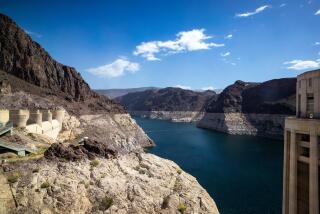Rationing Starts but Rains May Curtail Future Cuts
Mandatory water rationing began in Glendale on Monday with a steady stream of questions from residents, landlords and businesses about how and how much to conserve, city officials said.
Meanwhile, recent statewide storms are expected to improve local water supplies, which probably will make harsher cutbacks unnecessary, officials said. They warned last month that a worsening drought might require more severe rationing levels in the summer.
Under a plan approved last month by the City Council, residents and most small businesses are required to cut their water use by 20% from 1989 levels.
All of the city’s 32,000 customers were notified last week that they are obligated to reduce their water consumption by 20%. Businesses that use water to make products or provide services, such as a Laundromat or carwash, can appeal to the city for a 10% reduction, said Don Froelich, water services administrator.
All customers will be guaranteed a minimum amount of water and may appeal for more water than is allowed under rationing.
A public education campaign and the recent storms have helped ease concerns and confusion about mandatory water rationing, Froelich said.
The council’s rationing plan was the result of a decision last month by the Metropolitan Water District to cut regional allotments by 50%. The city receives 90% of its water from the MWD; the rest comes from local wells.
But Glendale city officials said they expect the MWD soon to reduce its cutback to 31% because of the storms. That means Glendale probably will not have to increase its rationing levels during the summer, Froelich said.
“A month or six weeks ago, there was a lot of apprehension. Industry thought it was going to have to shut down, hospitals were concerned they wouldn’t have enough water for patient care,” he said. “Now they feel we’re going to do just fine, and it may not be that bad.”
The city’s water hot line on Monday received more than 300 calls, ranging from homeowners requesting free conservation kits and inexpensive, low-flow shower heads to landlords asking about rebate programs for installing water-saving toilets, said Danielle Salkin, customer service administrator for Glendale’s water department.
But some calls came from worried landlords and property managers who said they did not know how to cut water use in commercial and multifamily buildings or how to enforce rationing on their tenants.
Many of the properties have central meters, making the landlord or property manager responsible for the tenants’ water usage. The central system makes it difficult to track down individual violators, city officials were told.
And, unlike houses, the properties usually do not have large lawns or other landscaping that can serve as the main target for water cutbacks, the owners said.
“The problem is, an owner of a large apartment building that has no outside things to water has very little opportunity to cut back,” said Frank Drewe, who owns a 41-unit apartment complex on Palmer Avenue. “I don’t know whether we can meet the requirement or not.”
Drewe said he bought the two-story building 12 years ago and installed low-flow shower heads, solar panels on the roof and fluorescent lighting in the hallways to conserve water and energy.
Since the city drafted its rationing plan, he has packed redwood bark mulch around his rosebushes to help retard evaporation, installed a low-flow sprinkler system and warned his tenants that he will pass on any penalties for excessive water use, he said.
He said he also is considering buying ultra-low-flow toilets or other toilet conservation devices under the city’s rebate program. The city is offering rebates of $100 per toilet for landlords who install certain low-flow models in their apartment or office buildings, Salkin said.
Meanwhile, Stevenson Property Management, which manages 15 office buildings and several apartment complexes in Glendale, has stopped washing off parking lots, limited sprinkler use and ordered thousands of shower heads and toilet conservation devices, mostly for the residential properties, said Mark Trueblood, Stevenson’s vice president.
“We’ve got our work cut out for us,” Trueblood said. “It’s an extra function of management that didn’t exist until today. Not only do we manage property, now we manage water.”
The company has been reluctant to let landscaping at the commercial buildings dry up because it helps attract and retain tenants. But executives are considering drought-resistant landscaping for two buildings now being designed, Trueblood said.
“One thing we’re finding is that businesses say they can’t live with reduction, but when their feet are put to the fire ... it’s interesting to see what imaginative things they can come up with,” Froelich said.
For its part, the city is installing toilet conservation devices and low-flow shower heads at municipal, police and fire facilities. Watering at parks has been reduced, production from local wells has been stepped up and more reclaimed water is being used at the city’s power plant, officials said.
Maintenance workers shut off and drained the city’s fountain outside the Municipal Services Building and two smaller fountains on Maryland Avenue, even though the fountains recirculated water.
And the Glendale Redevelopment Agency sent letters to companies in downtown buildings, such as the Allstate Plaza at 801 N. Brand Blvd., urging them to turn off their recirculating fountains or pools. Such facilities may give residents the impression that the drought is over, city officials said.
A spokeswoman for the Allstate Plaza said it is unlikely that the building’s reflecting pools will be drained. An architect is studying the problem, but officials believe that the pools’ costly liners would be damaged if drained of water, she said.
More to Read
Sign up for Essential California
The most important California stories and recommendations in your inbox every morning.
You may occasionally receive promotional content from the Los Angeles Times.










